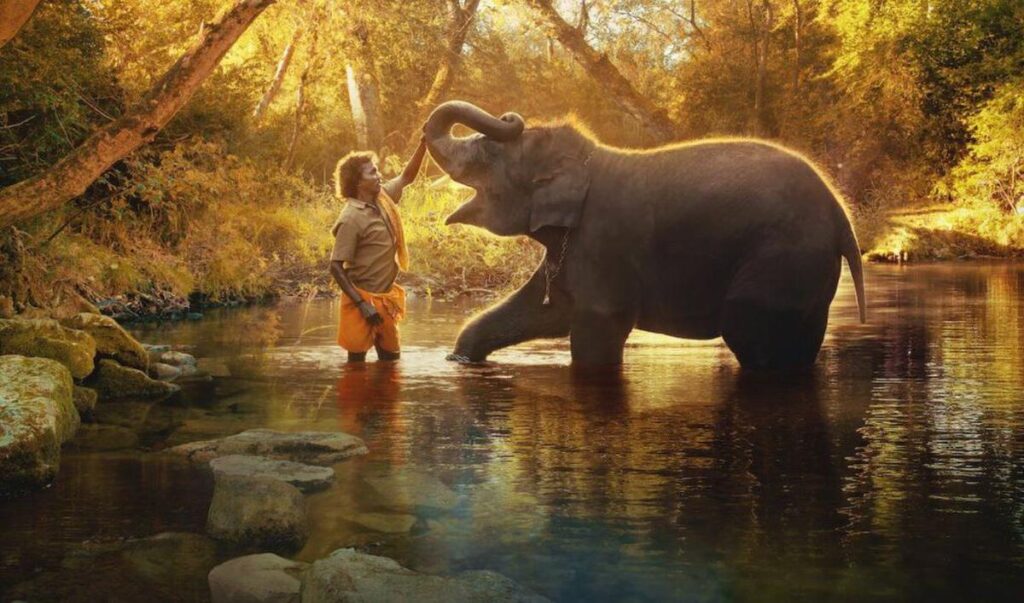The Elephant Whisperers (2022), directed by Kartiki Gonsalves and streaming on Netflix, depicts the touching tale of two elderly people, Bomman and Bellie, living in a village in Tamil Nadu near the Theppakadu Elephant Camp, one of the oldest elephant camp in Asia. They have dedicated their lives to taking care of and parenting two young orphaned elephants. The documentary charts their bonding with the majestic creatures and over the years explores how this has developed into an uplifting relationship, uniting them as a family. The 41-minute film has been shortlisted for the Oscars with fourteen other films in the Documentary Short section.
Bomman considers the forest to be his home where his ancestors have lived for generations. Whereas, Bellie was not a professional caretaker to begin with. But when she first encountered the baby elephant, Raghu, he tugged at her clothes like a child and she instantly fell in love with the creature. Later, the forest department allowed her to work with Bomman and take care of Raghu. That is how she became the only woman caretaker of elephants in Tamil Nadu. As the story goes on, we follow their everyday activities, conversations with the elephant, and marvel at their knowledge of looking after Raghu’s needs. We are also introduced to Ammu, a second baby elephant who receives the same care and love from the two. As the documentary comes to a close, we are informed that Bellie and Bomman are the first couple in South India to successfully rear two elephants.
By using Raghu and Ammu as mediums, Gonsalves allows us to get a look into the lives of Bomman and Bellie. By working with one another for years, both of them became close and eventually tie the knot. Caring for the baby elephants and protecting the forest is what has become a means of existence for this couple. Booman equates the presence of the elephants as God in their lives. Bellie lost her daughter while her ex-husband was killed from an attack by a tiger. So, looking after Raghu and then Ammu has helped her to forget all her worries. All this information helps us to understand just how close the bonding between man and animals can play to develop a connection with the environment that supports both of us. Further, it gives us a glimpse of how wide and magnificent such relationships are, covered in nature’s wealth. In doing so, Gonsalves knits the structure of the film with a wide objective point-of-view rather than inviting the viewers to form a subjective opinion vis-à-vis the characters and their activities. In one of the film’s unforgettable scenes, once Bomman and Bellie marry, they take a typical ‘family’ photograph with Raghu and Ammu as the children.
In terms of cinematic craft, rather than using a more conventional method of interviewing the characters, Gonsalves uses the relevant pieces of information that the characters reveal in the background as a commentary of sorts as they go on with their daily lives. This technique works in the beginning but soon we are inundated with so many details that it turns the otherwise richly visualized documentary into a verbose extravaganza. In a similar manner, through the length of the documentary, the background plays almost constantly to (unnecessary) act as a crutch to guide our emotions. It becomes so overused that we long for some silent and introspective moments to empathize with our characters. In one of the scenes towards the end, Bomman informs us that Raghu has been assigned a new caretaker. This breaks his heart and he cries. The camera frames him in a close-up and the background score turns melodramatic rather than letting us take in the tragically heart-breaking moment. In other scenes, when Bellie’s granddaughter, Santana is introduced, she is captured in slow motion with the obvious background score playing. By doing this, the director detaches the material from the creative opacity and aesthetic purity it merits.
There are four cinematographers, Karan Thapliyal, Krish Makhija, Anand Bansal and Kartiki herself, who frames the characters and the forest in a continual display of stunning cinematic compositions. At the same time, shots adhering to the ‘Nat Geo’ aesthetics of capturing the wildlife flora and fauna are used far too often to evoke a feeling of forced appreciation for nature. The editing by Sanchari Das Mollick and Douglas Blush creates a seamlessness that allows us to probe into the lives of these straightforward characters. Anthony BJ Ruban layers the narrative with the ambient sound of nature and its surroundings carefully to enhance the mood even being overpowered by the background score by Sven Faulconer.
Kartiki and her team have done a commendable job by bringing forward to the world the tale of a motivating selfless couple and their commitment to aiding the young elephants unconditionally. It is an uplifting, touching and informative documentary in its best moments but also frustratingly much too ‘filmi-like’ in others. This stops it from being truly there.
PS: The Elephant Whisperers has made it to the final nominations for the Oscars.
Tamil, Documentary, Short, Color


